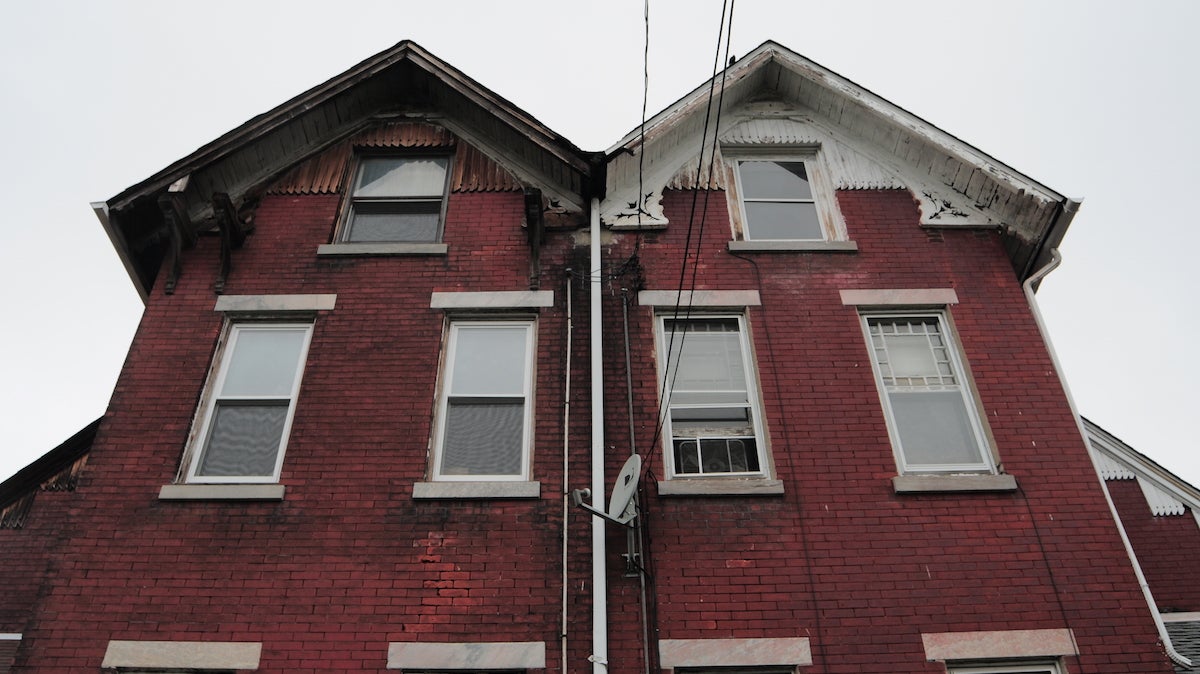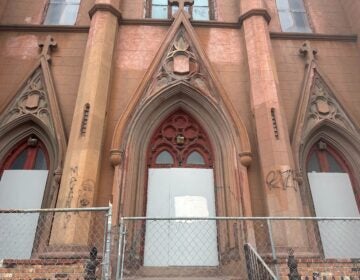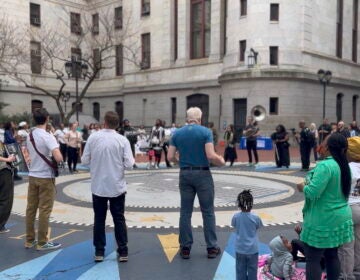Multi-pronged battle ahead for group of neighbors trying to save historic Wissahickon house

The twin homes are described as extraordinary examples of Eastlake Victorian architecture. (Bas Slabbers/for NewsWorks)
Neighbors are fervently trying to save a distinctive 1880s twin house in Roxborough from demolition, but they are waging difficult battles on several fronts.
A demolition permit is posted on the front door, allowing for the razing of the structure since May 7 so that the new owner can redevelop the site with 10 new housing units.
A nomination of the property to the Philadelphia Register of Historic Places won’t be reviewed until June 9 and wouldn’t be considered by the Philadelphia Historical Commission until July 10.
In addition, the PHC has stressed that the nomination should include the other twin house, though its owners have been staunchly opposed to designation.
Even if the PHC adds the properties to the historic register, it would not necessarily protect them from being knocked down because the original demolition permit was issued before the owner was notified of the historic nomination.
And yet, the members of the Wissahickon Interested Citizen’s Association remain steadfast and seem confident they will save the house at 145 Sumac Street. Jeffrey Allegretti, who serves on WICA’s zoning committee, said the focus for now is on the court battle to rescind the demolition permit.
The goal, he said, is to bring the owner “back to the table” to negotiate a plan that would allow new housing but preserve the 19th-century buildings
David Orphanides, the attorney for property owner John Messing, said on May 18 that “they are not running out this week” to take down 145 Sumac, and he has promised advance notice to WICA’s attorney when demolition was set to begin.
Historic significance
At a meeting of the historic designation committee of the PHC on March 26, the twin homes were described as extraordinary examples of Eastlake Victorian architecture, among just a few such houses in the Wissahickon area (which was developed at a time when the Queen Anne style was in vogue).
Experts at the meeting said the houses were built in 1883 and 1884, possibly by mason John Gilton, who is known for the magnificent, recently restored Nugent Home for Baptists in Germantown. The land on which the Sumac Street homes were built was likely owned by the prominent Camac family, and 145 Sumac was the home of Manayunk mill owner James Z. Holt, whose company helped develop the Wissahickon neighborhood.
Allegretti, who wrote the nominations for both Sumac Street homes, said members of the PHC staff have told him the buildings are certainly worthy of historic designation. “But to say this house is so important is to make the wrong case” for preserving it, he said.
Sumac Street, he explained, was a 19th-century “McMansion development,” a place where merchants, bankers and other affluent professionals chose to build their homes and created their own styles. “This was really the main street. When people were picking lots in Wissahickon, they were picking them on Sumac. This is really where the most significant houses happened.”
The Holt family purchased the property at 145 Sumac with the idea of creating an estate with two development plots next to the main house and five lots behind it. There is certainly space to develop, Allegretti said.
But the original houses define the character of Sumac Street, he continued. “So that’s what we lose” if the buildings are razed. “All of these houses could by-right become just a bunch of new units if you tore down the beautiful things that are there.”
PHC executive director Jonathan Farnham said the Commission is reviewing the nominations.
But the owner of 145 Sumac applied for a demolition permit “before the Commission’s jurisdiction went into effect. The jurisdiction is initiated by a letter informing the owner of the Commission’s intent to consider a nomination. Therefore, the permit resulting from the application is beyond the Historical Commission’s reach; the Commission does not have the authority to review that demolition permit application,” Farnham explained. “With that permit, the owner may legally demolish the building without the Commission’s intervention, perhaps before the Commission considers the nomination.”
Failed negotiations
The property referred to as the Holt House in the PHC meeting minutes more recently had been owned by an elderly brother and sister until they died. The deed of the house went to Messing around 2010, Allegretti said.
The parcel was placed on the market in October 2014, and a first meeting between WICA and the owner and his attorney occurred in November. Allegretti said the group was presented with a “crude site plan” for development at 145 Sumac. The plan showed “10 houses arranged sideways to the street facing each other. The [original] house is gone.”
Allegretti said WICA asked the owner to consider ways to develop the site without demolishing the house. The owner responded that he can demolish the building “as right” and left the meeting, Allegretti said.
Orphanides, the owner’s attorney, said, “We got off on a very bad foot” with WICA. He arrived late for the meeting, he said, and when he arrived found a very contentious conversation underway, with WICA threatening lawsuits.
Later in November, Allegretti began the historic nominating process for 145 Sumac. He submitted a formal nomination package in mid-December and received a request in mid-January to address deficiencies in the nomination. When he sent the revised application in, he was told the nomination for 145 Sumac would be “compromised” without a similar nomination for the twin house at 147 Sumac. That nomination was submitted on Jan. 26. Allegretti said he “pleaded” with PHC on Feb. 10 to notify the owner of 145 Sumac of the nominations in order to prevent the “as-right” demolition of the property.
On Feb. 13, a contractor for the owner filed for a demolition permit for 145 Sumac. The historic nomination notification went out five days later.
The initial demolition application from the contractor was rejected by the Department of Licenses & Inspections on Feb. 20 because the contractor was deemed unqualified.
A second contractor who was on the city’s master demolition list was then granted in April the right to perform the work based on the original permit. “Some in the community believed they should have been made to apply again,” said Josh Cohen, special assistant to Councilman Curtis Jones.
WICA has appealed the demolition approval to the Board of Licenses & Inspections Review and started action for an injunction in the Court of Common Pleas to halt demolition. The second contractor has since agreed to terminate his demolition contract in order to avoid further legal action. A court hearing on the demolition permit has not been set.
Conditions of the properties
Though it has been drawn into the nominating process, the owners of the twin home at 147 Sumac expressed their opposition to historic designation at the PHS meeting in March. Owner Deborah Gribben-Zameska, who has lived in the house for 50 years, told Commission members that she and her husband could not afford to restore the house, including its slate roof or original windows, if it is deemed historic.
She was informed by the PHC that the owners would not be required to undertake any work if the house was designated, and the property could continue in its current condition forever.
At the same hearing, Messing, the owner of 145 Sumac, said that property is deteriorated and about to fall, and would pull 147 down with it, according to minutes from the meeting.
In an interview in May at the Sumac Street site, Allegretti, whose firm Innova Redevelopment focuses on restoration and affordable housing, said there is “absolutely nothing threatening that building of coming down.” Porch columns are failing, the roof is leaking, and “massive amount of brick-pointing needs to be done,” he said, “but all that stuff is so easy to fix.”
WICA members who have seen the interior of 145 Sumac describe original plaster and crown moldings, decorative rosettes, original light fixtures and woodwork, and floors with beautiful inlaid designs.
“You can’t believe the treasures that are in that house,” said Bernardino Allegretti, Jeffrey’s son.
Back to the table?
Since the initial meeting in November, Orphanides said he has tried to arrange another sit-down with WICA through Josh Cohen of Fourth Distric Councilman Curtis Jones Jr.’s office. “I told him what would be required to start talking again. The bottom line is, it would have to be something that would convey an interest in changing their attitude toward this [project],” Orphanides said.
He said he has contacted WICA’s attorney, Hal Schirmer, and “put the same thing to him. But I never heard anything back. We’re interested in seeing if there is anything that can be done, but I’ve heard nothing from their side,” Orphanides said.
Bernardino Allegretti said WICA has never been opposed to development of the parcel on Sumac Street. “But it’s a prominent intersection and we want to preserve this part of the character of the neighborhood,” he said.
Jeffrey Allegretti said that if the demolition permit is rescinded “and we have effectively stopped the demolition because they will have to reapply, I’d like to believe the Historical Commission would not allow them to proceed.”
All of these actions, he said, are “really to drive them back to the table. We’re preservationists at heart, and it would be nice if the buildings were lovingly restored.” But the group would be satisfied, he said, if the all the parties could agree on “a less destructive development.”
PlanPhilly is now a project of WHYY/NewsWorks. It began in 2006 as an initiative of Penn Praxis inside the University of Pennsylvania School of Design. Though now part of WHYY, PlanPhilly still works closely with Penn Praxis in covering planning, zoning and development news. Contact Alan Jaffe at ajaffe@planphilly.com.
WHYY is your source for fact-based, in-depth journalism and information. As a nonprofit organization, we rely on financial support from readers like you. Please give today.






